Colossal Dielectric Constant of Nanocrystalline/Amorphous Homo-Composite BaTiO3 Films Deposited via Pulsed Laser Deposition Technique
Abstract
1. Introduction
2. Materials and Methods
2.1. Film and Electrode Fabrication
2.2. Characterizations of the PLD-BTO Films
3. Results
4. Discussion
5. Conclusions
Supplementary Materials
Author Contributions
Funding
Data Availability Statement
Acknowledgments
Conflicts of Interest
References
- Hong, K.; Lee, T.H.; Suh, J.M.; Yoon, S.-H.; Jang, H.W. Perspectives and Challenges in Multilayer Ceramic Capacitors for next Generation Electronics. J. Mater. Chem. C 2019, 7, 9782–9802. [Google Scholar] [CrossRef]
- Yoon, S.-H.; Kim, M.-Y.; Nam, C.-H.; Seo, J.-W.; Wi, S.-K.; Hur, K.-H. Grain-Growth Effect on Dielectric Nonlinearity of BaTiO3-Based Multi-Layer Ceramic Capacitors. Appl. Phys. Lett. 2015, 107, 072906. [Google Scholar] [CrossRef]
- Buscaglia, M.T.; Viviani, M.; Buscaglia, V.; Mitoseriu, L.; Testino, A.; Nanni, P.; Zhao, Z.; Nygren, M.; Harnagea, C.; Piazza, D.; et al. High Dielectric Constant and Frozen Macroscopic Polarization in Dense Nanocrystalline BaTiO3 Ceramics. Phys. Rev. B 2006, 73, 064114. [Google Scholar] [CrossRef]
- Teranishi, T.; Ozaki, R.; Kondo, S.; Kishimoto, A. Polarization Contributions to DC Bias Characteristics of Nanograined BaTiO3-Based Ceramics. Jpn. J. Appl. Phys. 2023, 62, SM1015. [Google Scholar] [CrossRef]
- Zhu, C.; Cai, Z.; Guo, L.; Li, L.; Wang, X. Grain Size Engineered High-performance Nanograined BaTiO3-based Ceramics: Experimental and Numerical Prediction. J. Am. Ceram. Soc. 2021, 104, 273–283. [Google Scholar] [CrossRef]
- Raeder, T.M.; Holstad, T.S.; Nylund, I.-E.; Einarsrud, M.-A.; Glaum, J.; Meier, D.; Grande, T. Anisotropic In-Plane Dielectric and Ferroelectric Properties of Tensile-Strained BaTiO3 Films with Three Different Crystallographic Orientations. AIP Adv. 2021, 11, 025016. [Google Scholar] [CrossRef]
- Hosokura, T.; Ando, A.; Konoike, T. Orientation-Controlled BaTiO3 Thin Films Fabricated by Chemical Solution Deposition. RSC Adv. 2015, 5, 97563–97567. [Google Scholar] [CrossRef]
- Peng, W.; Zorn, J.A.; Mun, J.; Sheeraz, M.; Roh, C.J.; Pan, J.; Wang, B.; Guo, K.; Ahn, C.W.; Zhang, Y.; et al. Constructing Polymorphic Nanodomains in BaTiO3 Films via Epitaxial Symmetry Engineering. Adv. Funct. Mater. 2020, 30, 1910569. [Google Scholar] [CrossRef]
- Everhardt, A.S.; Denneulin, T.; Grünebohm, A.; Shao, Y.-T.; Ondrejkovic, P.; Zhou, S.; Domingo, N.; Catalan, G.; Hlinka, J.; Zuo, J.-M.; et al. Temperature-Independent Giant Dielectric Response in Transitional BaTiO3 Thin Films. Appl. Phys. Rev. 2020, 7, 011402. [Google Scholar] [CrossRef]
- Kullmer, R. Dielectric and Ferroelectric Properties of Pulsed-Laser Deposited BaTiO3 Films. Appl. Phys. A 1997, 65, 273–279. [Google Scholar] [CrossRef]
- Gottmann, J.; Kreutz, E.W. Controlling Crystal Quality and Orientation of Pulsed-Laser-Deposited BaTiO3 Thin Films by the Kinetic Energy of the Film-Forming Particles. Appl. Phys. A 2000, 70, 275–281. [Google Scholar] [CrossRef]
- Berge, J.; Vorobiev, A.; Gevorgian, S. The Effect of Growth Temperature on the Nanostructure and Dielectric Response of BaTiO3 Ferroelectric Films. Thin Solid Films 2007, 515, 6302–6308. [Google Scholar] [CrossRef]
- Ihlefeld, J.F.; Daniels, P.R.; Aygün, S.M.; Borland, W.J.; Maria, J.-P. Property Engineering in BaTiO3 Films by Stoichiometry Control. J. Mater. Res. 2010, 25, 1064–1071. [Google Scholar] [CrossRef]
- Ihlefeld, J.F.; Borland, W.J.; Maria, J.-P. Enhanced Dielectric and Crystalline Properties in Ferroelectric Barium Titanate Thin Films. Adv. Funct. Mater. 2007, 17, 1199–1203. [Google Scholar] [CrossRef]
- Ihlefeld, J.F.; Vodnick, A.M.; Baker, S.P.; Borland, W.J.; Maria, J.-P. Extrinsic Scaling Effects on the Dielectric Response of Ferroelectric Thin Films. J. Appl. Phys. 2008, 103, 074112. [Google Scholar] [CrossRef]
- Wu, Y.J.; Li, J.; Tanaka, H.; Kuwabara, M. Preparation of Nano-Structured BaTiO3 Thin Film by Electrophoretic Deposition and Its Characterization. J. Eur. Ceram. Soc. 2005, 25, 2041–2044. [Google Scholar] [CrossRef]
- Yamashita, Y.; Yamamoto, H.; Sakabe, Y. Dielectric Properties of BaTiO3 Thin Films Derived from Clear Emulsion of Well-Dispersed Nanosized BaTiO3 Particles. Jpn. J. Appl. Phys. 2004, 43, 6521. [Google Scholar] [CrossRef]
- Fujita, J.; Suzuki, K.; Wada, N.; Sakabe, Y.; Takeuchi, K.; Ohki, Y. Dielectric Properties of BaTiO3 Thin Films Prepared by Laser Ablation. Jpn. J. Appl. Phys. 2006, 45, 7806–7812. [Google Scholar] [CrossRef]
- Suzuki, K.; Kijima, K. Dielectric Properties of BaTiO3 Films Prepared by RF-Plasma Chemical Vapor Deposition. Jpn. J. Appl. Phys. 2005, 44, 8528. [Google Scholar] [CrossRef]
- Nakasone, F.; Kobayashi, K.; Suzuki, T.; Mizuno, Y.; Chazono, H.; Imai, H. Nanoparticle-Sintered BaTiO3 Thin Films and Its Orientation Control by Solid Phase Epitaxy. Jpn. J. Appl. Phys. 2008, 47, 8518–8524. [Google Scholar] [CrossRef]
- Zhang, L.; Tang, Z.-J. Polaron Relaxation and Variable-Range-Hopping Conductivity in the Giant-Dielectric-Constant Material CaCu3Ti4O12. Phys. Rev. B 2004, 70, 174306. [Google Scholar] [CrossRef]
- Adams, T.B.; Sinclair, D.C.; West, A.R. Characterization of Grain Boundary Impedances in Fine- and Coarse-Grained CaCu3Ti4O12 Ceramics. Phys. Rev. B 2006, 73, 094124. [Google Scholar] [CrossRef]
- Wang, C.C.; Zhang, L.W. Surface-Layer Effect in CaCu3Ti4O12. Appl. Phys. Lett. 2006, 88, 042906. [Google Scholar] [CrossRef]
- Wang, C.C.; Zhang, L.W. Polaron Relaxation Related to Localized Charge Carriers in CaCu3Ti4O12. Appl. Phys. Lett. 2007, 90, 142905. [Google Scholar] [CrossRef]
- Si, W.; Cruz, E.M.; Johnson, P.D.; Barnes, P.W.; Woodward, P.; Ramirez, A.P. Epitaxial Thin Films of the Giant-Dielectric-Constant Material CaCu3Ti4O12 Grown by Pulsed-Laser Deposition. Appl. Phys. Lett. 2002, 81, 2056–2058. [Google Scholar] [CrossRef]
- Liu, L.; Ren, S.; Liu, J.; Han, F.; Zhang, J.; Peng, B.; Wang, D.; Bokov, A.A.; Ye, Z.-G. Localized Polarons and Conductive Charge Carriers: Understanding CaCu3Ti4O12 over a Broad Temperature Range. Phys. Rev. B 2019, 99, 094110. [Google Scholar] [CrossRef]
- Lin, Y.; Jiang, L.; Zhao, R.; Nan, C.-W. High-Permittivity Core/Shell Stuctured NiO-Based Ceramics and Their Dielectric Response Mechanism. Phys. Rev. B 2005, 72, 014103. [Google Scholar] [CrossRef]
- Song, Y.; Wang, X.; Sui, Y.; Liu, Z.; Zhang, Y.; Zhan, H.; Song, B.; Liu, Z.; Lv, Z.; Tao, L.; et al. Origin of Colossal Dielectric Permittivity of Rutile Ti0.9In0.05Nb0.05O2: Single Crystal and Polycrystalline. Sci. Rep. 2016, 6, 21478. [Google Scholar] [CrossRef]
- Gai, Z.; Cheng, Z.; Wang, X.; Zhao, L.; Yin, N.; Abah, R.; Zhao, M.; Hong, F.; Yu, Z.; Dou, S. A Colossal Dielectric Constant of an Amorphous TiO2:(Nb, In) Film with Low Loss Fabrication at Room Temperature. J. Mater. Chem. C 2014, 2, 6790–6795. [Google Scholar] [CrossRef]
- Lunkenheimer, P.; Bobnar, V.; Pronin, A.V.; Ritus, A.I.; Volkov, A.A.; Loidl, A. Origin of Apparent Colossal Dielectric Constants. Phys. Rev. B 2002, 66, 052105. [Google Scholar] [CrossRef]
- Wu, Y.J.; Su, S.H.; Cheng, J.P.; Chen, X.M. Spark Plasma Sintering of Barium Zirconate Titanate/Carbon Nanotube Composites with Colossal Dielectric Constant and Low Dielectric Loss. J. Am. Ceram. Soc. 2011, 94, 663–665. [Google Scholar] [CrossRef]
- Teranishi, T.; Nishikori, Y.; Yoneda, M.; Kishimoto, A. Controlled Colossal Polarization Originating in the Li-Ion Conductor–Dielectric Interface. Jpn. J. Appl. Phys. 2021, 60, 040905. [Google Scholar] [CrossRef]
- Teranishi, T.; Matsui, H.; Kondo, S.; Kishimoto, A. Spinodal Decomposition-Derived Giant Polarization in TiO2–SnO2 Generated from a Metastable Phase. J. Appl. Phys. 2023, 133, 174101. [Google Scholar] [CrossRef]
- Teranishi, T.; Satake, J.; Kondo, S.; Kishimoto, A. Polarization at the Compositional Interface in Nb-Doped Metastable TiO2-SnO2 Solid Solutions. Jpn. J. Appl. Phys. 2024, 63, 07SP05. [Google Scholar] [CrossRef]
- Pecharromán, C.; Esteban-Betegón, F.; Bartolomé, J.F.; López-Esteban, S.; Moya, J.S. New Percolative BaTiO3–Ni Composites with a High and Frequency-Independent Dielectric Constant (ϵr ≈ 80000). Adv. Mater. 2001, 13, 1541–1544. [Google Scholar] [CrossRef]
- Yuan, J.; Yao, S.; Li, W.; Sylvestre, A.; Bai, J. Vertically Aligned Carbon Nanotube Arrays on SiC Microplatelets: A High Figure-of-Merit Strategy for Achieving Large Dielectric Constant and Low Loss in Polymer Composites. J. Phys. Chem. C 2014, 118, 22975–22983. [Google Scholar] [CrossRef]
- Mouloua, D.; LeBlanc-Lavoie, J.; Pichon, L.; Rajput, N.S.; Marssi, M.E.; Jouiad, M.; Khakani, M.A.E. Tuning the Optoelectronic Properties of Pulsed Laser Deposited “3D”-MoS2 Films via the Degree of Vertical Alignment of Their Constituting Layers. Adv. Opt. Mater. 2024, 12, 2302966. [Google Scholar] [CrossRef]
- Zhao, T.; Chen, F.; Lu, H.; Yang, G.; Chen, Z. Thickness and Oxygen Pressure Dependent Structural Characteristics of BaTiO3 Thin Films Grown by Laser Molecular Beam Epitaxy. J. Appl. Phys. 2000, 87, 7442–7447. [Google Scholar] [CrossRef]
- Guo, H.Z.; Chen, Z.H.; Cheng, B.L.; Lu, H.B.; Liu, L.F.; Zhou, Y.L. Structure Dynamics of Strongly Reduced Epitaxial BaTiO3−x Studied by Raman Scattering. J. Eur. Ceram. Soc. 2005, 25, 2347–2352. [Google Scholar] [CrossRef]
- Kim, W.J.; Chang, W.; Qadri, S.B.; Pond, J.M.; Kirchoefer, S.W.; Chrisey, D.B.; Horwitz, J.S. Microwave Properties of Tetragonally Distorted (Ba0.5Sr0.5)TiO3 Thin Films. Appl. Phys. Lett. 2000, 76, 1185–1187. [Google Scholar] [CrossRef]
- Chen, M.S.; Shen, Z.X.; Tang, S.H.; Shi, W.S.; Cui, D.F.; Chen, Z.H. Stress Effect on Raman Spectra of Ce-Doped BaTiO3 Films. J. Phys. Condens. Matter. 2000, 12, 7013. [Google Scholar] [CrossRef]
- Dobal, P.S.; Dixit, A.; Katiyar, R.S.; Yu, Z.; Guo, R.; Bhalla, A.S. Micro-Raman Scattering and Dielectric Investigations of Phase Transition Behavior in the BaTiO3–BaZrO3 System. J. Appl. Phys. 2001, 89, 8085–8091. [Google Scholar] [CrossRef]
- Teranishi, T.; Horiuchi, N.; Hoshina, T.; Takeda, H.; Tsurumi, T. Analysis on Dipole Polarization of BaTiO3-Based Ferroelectric Ceramics by Raman Spectroscopy. J. Ceram. Soc. Jpn. 2010, 118, 679–682. [Google Scholar] [CrossRef]
- Muniz, F.T.L.; Miranda, M.A.R.; dos Santos, C.M.; Sasaki, J.M. The Scherrer Equation and the Dynamical Theory of X-Ray Diffraction. Acta Crystallogr. Sect. A Found. Adv. 2016, 72, 385–390. [Google Scholar] [CrossRef] [PubMed]
- Sreenivas, K.; Mansingh, A.; Sayer, M. Structural and Electrical Properties of Rf-sputtered Amorphous Barium Titanate Thin Films. J. Appl. Phys. 1987, 62, 4475–4481. [Google Scholar] [CrossRef]
- Kamel, F.E.; Gonon, P.; Jomni, F.; Yangui, B. Dielectric Properties of Amorphous BaTiO3 Films Deposited by RF Magnetron Sputtering. J. Eur. Ceram. Soc. 2007, 27, 3807–3809. [Google Scholar] [CrossRef]
- Zgonik, M.; Bernasconi, P.; Duelli, M.; Schlesser, R.; Günter, P.; Garrett, M.H.; Rytz, D.; Zhu, Y.; Wu, X. Dielectric, Elastic, Piezoelectric, Electro-Optic, and Elasto-Optic Tensors of BaTiO3 Crystals. Phys. Rev. B 1994, 50, 5941–5949. [Google Scholar] [CrossRef]
- Lee, S.-J.; Kang, K.-Y.; Han, S.-K. Low-Frequency Dielectric Relaxation of BaTiO3 Thin-Film Capacitors. Appl. Phys. Lett. 1999, 75, 1784–1786. [Google Scholar] [CrossRef]
- Bidault, O.; Goux, P.; Kchikech, M.; Belkaoumi, M.; Maglione, M. Space-Charge Relaxation in Perovskites. Phys. Rev. B 1994, 49, 7868–7873. [Google Scholar] [CrossRef]
- Tang, Q.; Shen, M.; Fang, L. Anomalous Dielectric Properties in (Ba, Sr)TiO3 Films Fabricated by Pulsed-Laser Deposition in N2 Atmosphere. Solid State Commun. 2005, 135, 707–710. [Google Scholar] [CrossRef]
- Song, Y.; Wang, X.; Zhang, X.; Qi, X.; Liu, Z.; Zhang, L.; Zhang, Y.; Wang, Y.; Sui, Y.; Song, B. Colossal Dielectric Permittivity in (Al + Nb) Co-Doped Rutile SnO2 Ceramics with Low Loss at Room Temperature. Appl. Phys. Lett. 2016, 109, 142903. [Google Scholar] [CrossRef]
- Guillemet-Fritsch, S.; Valdez-Nava, Z.; Tenailleau, C.; Lebey, T.; Durand, B.; Chane-Ching, J.-Y. Colossal Permittivity in Ultrafine Grain Size BaTiO3−x and Ba0.95La0.05TiO3−x Materials. Adv. Mater. 2008, 20, 551–555. [Google Scholar] [CrossRef]
- Han, H.; Voisin, C.; Guillemet-Fritsch, S.; Dufour, P.; Tenailleau, C.; Turner, C.; Nino, J.C. Origin of Colossal Permittivity in BaTiO3 via Broadband Dielectric Spectroscopy. J. Appl. Phys. 2013, 113, 024102. [Google Scholar] [CrossRef]
- Valdez-Nava, Z.; Guillemet-Fritsch, S.; Tenailleau, C.; Lebey, T.; Durand, B.; Chane-Ching, J.Y. Colossal Dielectric Permittivity of BaTiO3-Based Nanocrystalline Ceramics Sintered by Spark Plasma Sintering. J. Electroceram. 2009, 22, 238–244. [Google Scholar] [CrossRef]
- Sagdeo, A.; Nagwanshi, A.; Pokhriyal, P.; Sinha, A.K.; Rajput, P.; Mishra, V.; Sagdeo, P.R. Disappearance of Dielectric Anomaly in Spite of Presence of Structural Phase Transition in Reduced BaTiO3: Effect of Defect States within the Bandgap. J. Appl. Phys. 2018, 123, 161424. [Google Scholar] [CrossRef]
- Yang, X.; Li, D.; Ren, Z.H.; Zeng, R.G.; Gong, S.Y.; Zhou, D.K.; Tian, H.; Li, J.X.; Xu, G.; Shen, Z.J.; et al. Colossal Dielectric Performance of Pure Barium Titanate Ceramics Consolidated by Spark Plasma Sintering. RSC Adv. 2016, 6, 75422–75429. [Google Scholar] [CrossRef]
- Yu, J.; Paradis, P.-F.; Ishikawa, T.; Yoda, S. Maxwell–Wagner Effect in Hexagonal BaTiO3 Single Crystals Grown by Containerless Processing. Appl. Phys. Lett. 2004, 85, 2899–2901. [Google Scholar] [CrossRef]
- Lenjer, S.; Schirmer, O.F.; Hesse, H.; Kool, T.W. Conduction States in Oxide Perovskites: Three Manifestations of Ti3+ Jahn-Teller Polarons in Barium Titanate. Phys. Rev. B 2002, 66, 165106. [Google Scholar] [CrossRef]
- Hardoň, Š.; Kúdelčík, J.; Baran, A.; Michal, O.; Trnka, P.; Hornak, J. Influence of Nanoparticles on the Dielectric Response of a Single Component Resin Based on Polyesterimide. Polymers 2022, 14, 2202. [Google Scholar] [CrossRef]
- Bidault, O.; Maglione, M.; Actis, M.; Kchikech, M.; Salce, B. Polaronic Relaxation in Perovskites. Phys. Rev. B 1995, 52, 4191–4197. [Google Scholar] [CrossRef]
- Artemenko, A.; Payan, S.; Rousseau, A.; Levasseur, D.; Arveux, E.; Guegan, G.; Maglione, M. Low Temperature Dielectric Relaxation and Charged Defects in Ferroelectric Thin Films. AIP Adv. 2013, 3, 042111. [Google Scholar] [CrossRef]
- Takahashi, S.; Imai, Y.; Kan, A.; Hotta, Y.; Ogawa, H. Microwave Dielectric Properties of Composites Consisting of MgAl2O4 Filler Synthesized by Molten-Salt Method and Isotactic Polypropylene Polymer Matrix. Jpn. J. Appl. Phys. 2015, 54, 10NE02. [Google Scholar] [CrossRef]
- Merad, S.; Autret-Lambert, C.; Zaghrioui, M.; Neacsa, D.; Motret, O.; Gervais, F. Constructing Multiple Heterogeneous Shell on the CaCu3Ti4O12 Core for Better Dielectric Performances. J. Solid State Chem. 2023, 328, 124339. [Google Scholar] [CrossRef]
- Xiao, S.; Gao, W.; Yao, M.; Su, Z.; Yao, X. High Dielectric Constant and Energy Density Achieved in Sandwich-Structured SrTiO3 Nanocomposite Thick Films by Interface Modulation. J. Mater. Chem. C 2018, 7, 673–681. [Google Scholar] [CrossRef]
- Xiao, S.; Yao, M.; Gao, W.; Su, Z.; Yao, X. Significantly Enhanced Dielectric Constant and Breakdown Strength in Crystalline@ amorphous Core-Shell Structured SrTiO3 Nanocomposite Thick Films. J. Alloys Compd. 2018, 762, 370–377. [Google Scholar] [CrossRef]
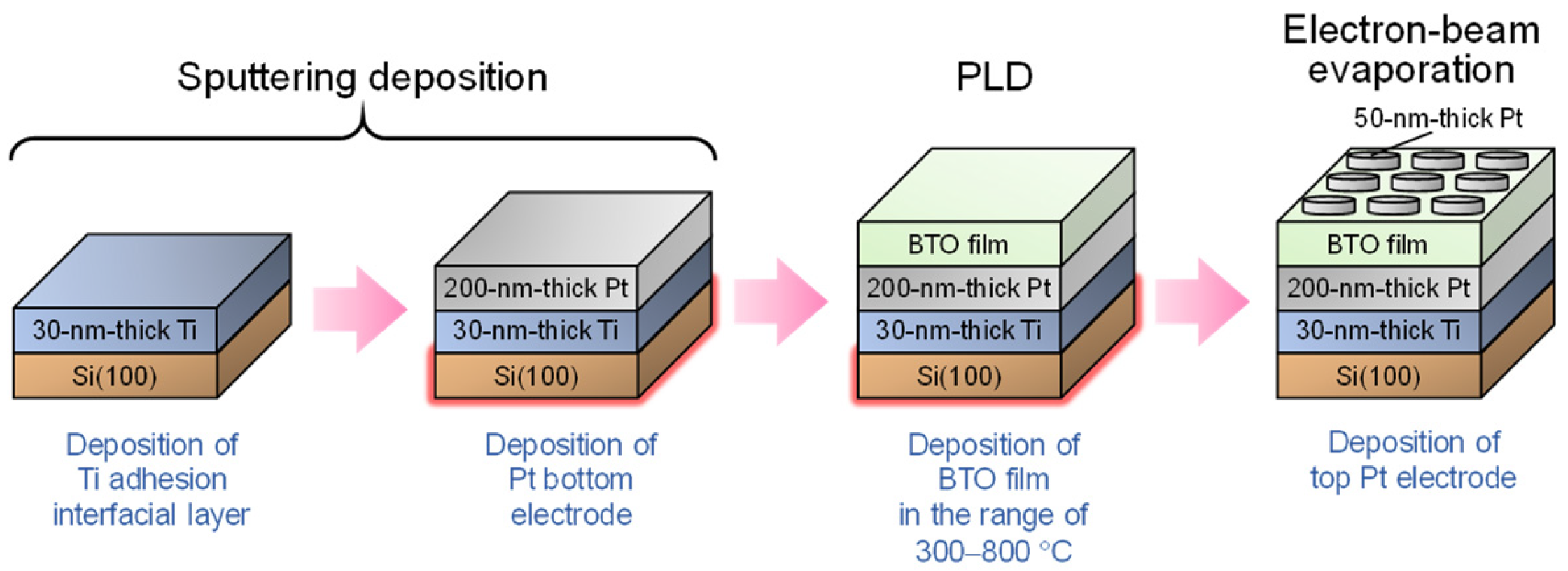
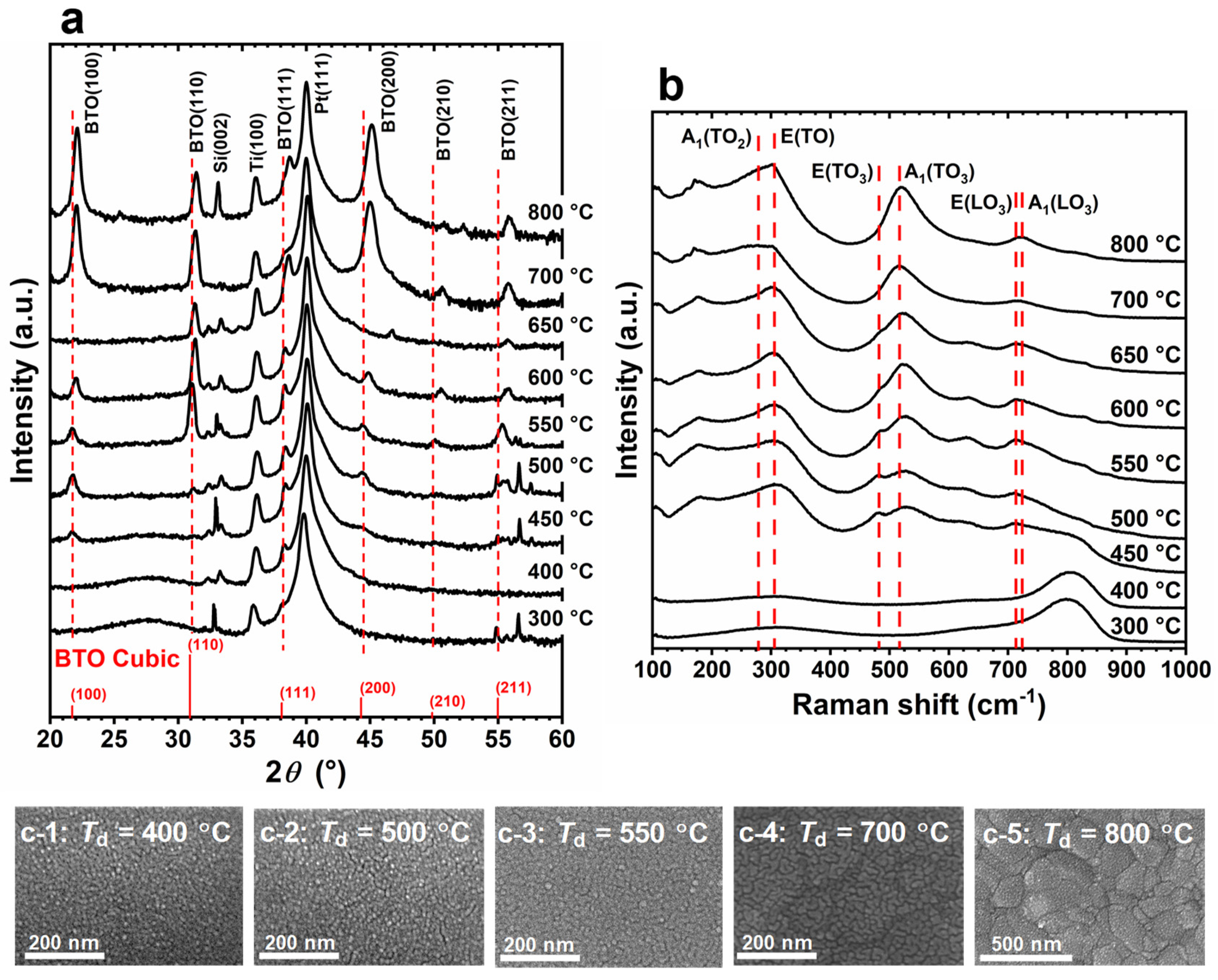
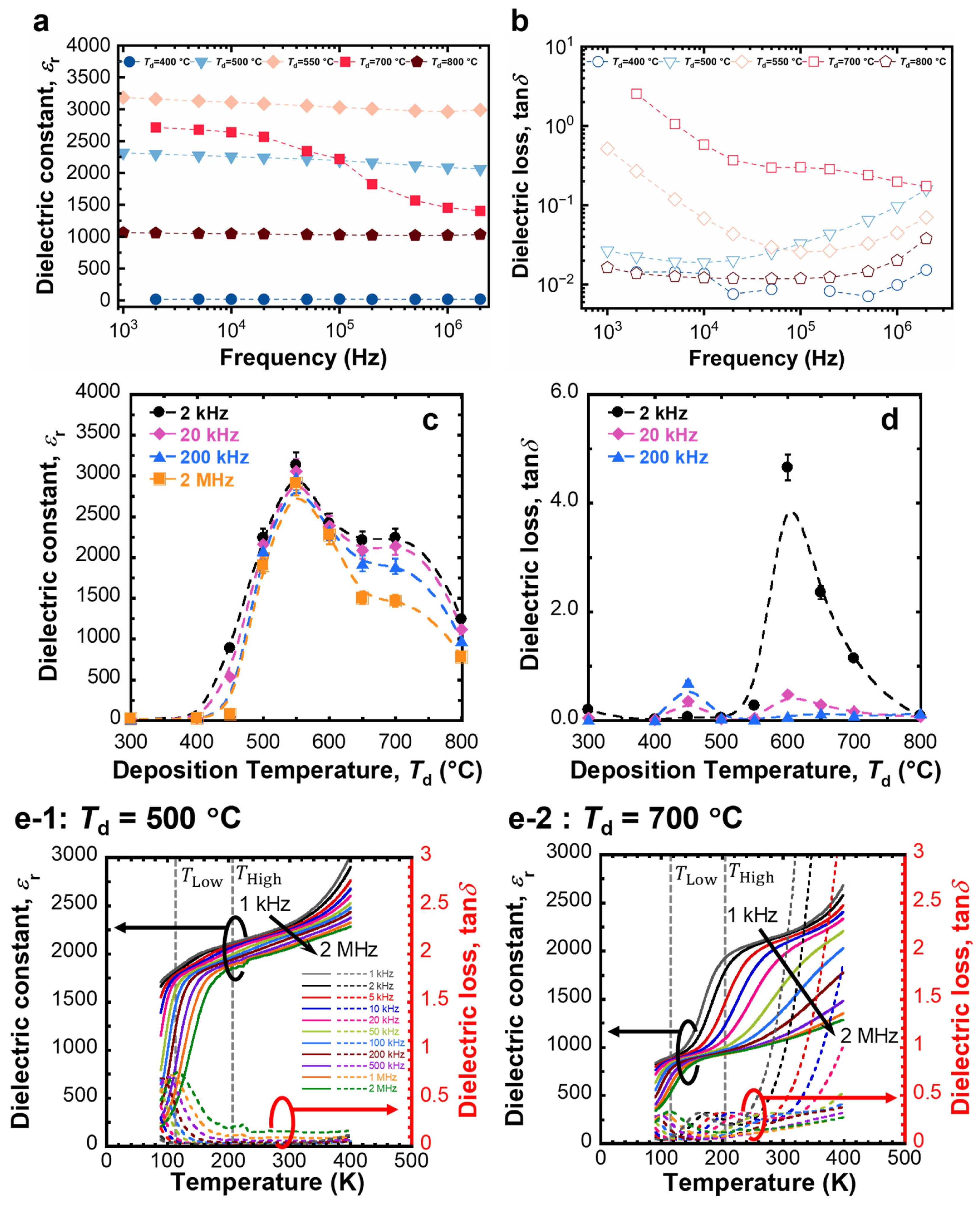
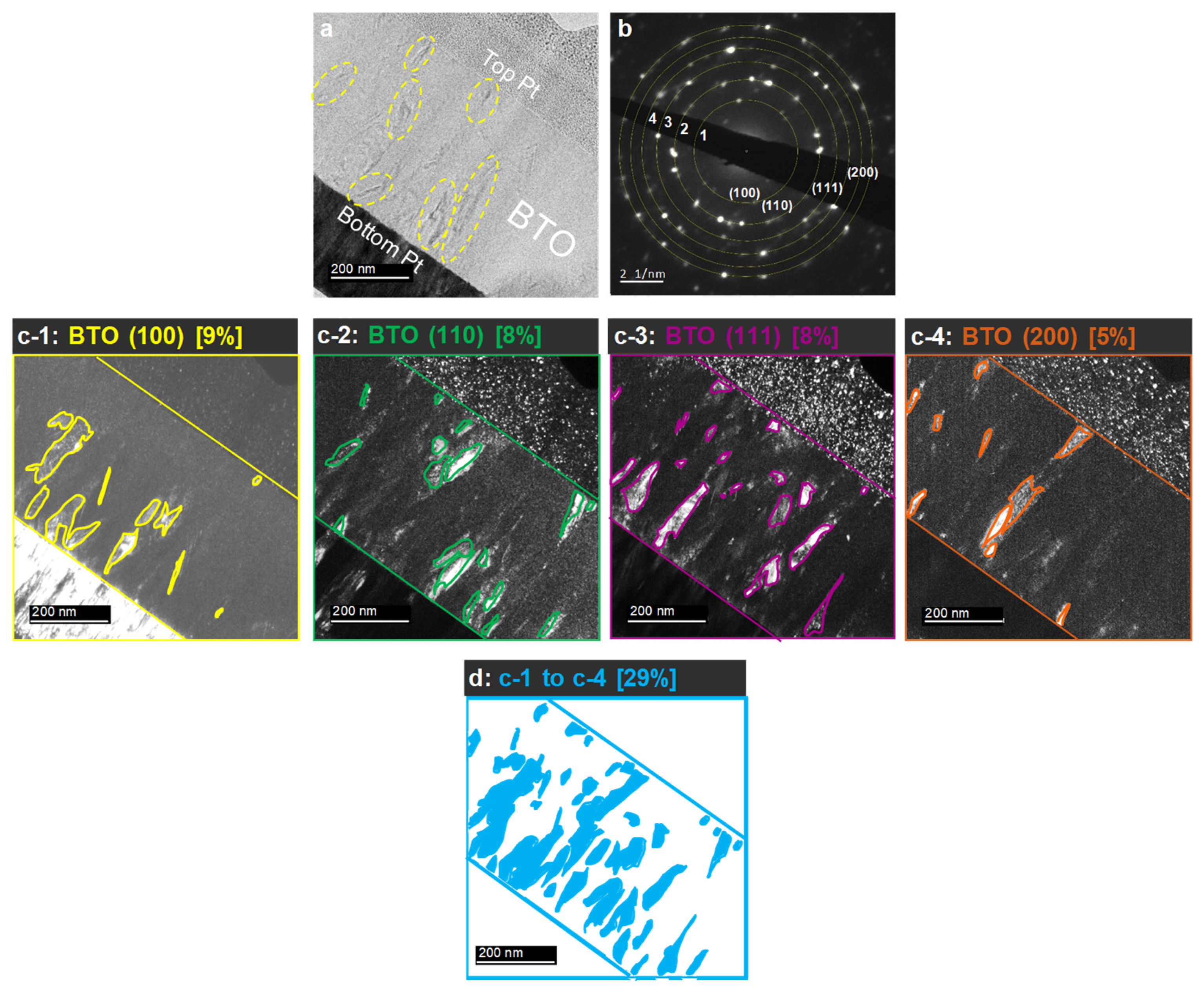
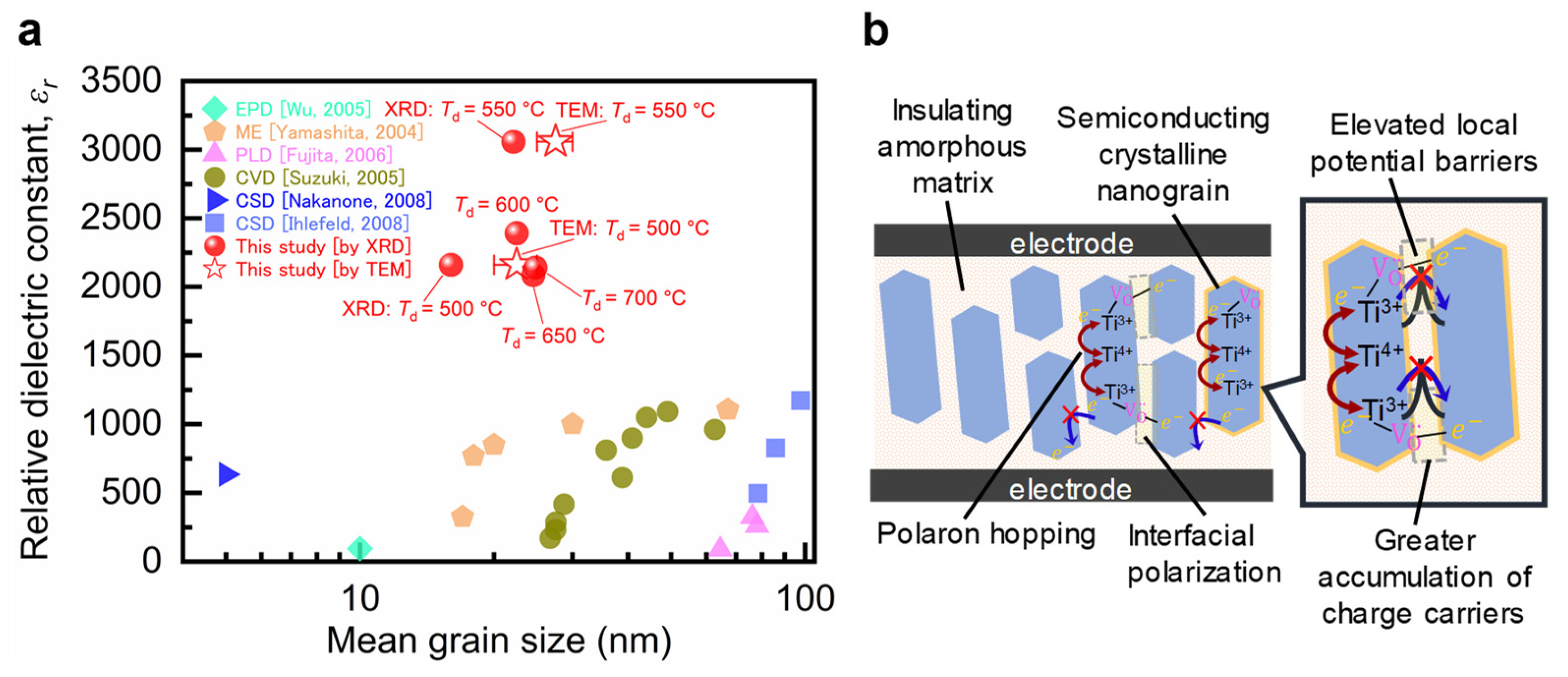
Disclaimer/Publisher’s Note: The statements, opinions and data contained in all publications are solely those of the individual author(s) and contributor(s) and not of MDPI and/or the editor(s). MDPI and/or the editor(s) disclaim responsibility for any injury to people or property resulting from any ideas, methods, instructions or products referred to in the content. |
© 2024 by the authors. Licensee MDPI, Basel, Switzerland. This article is an open access article distributed under the terms and conditions of the Creative Commons Attribution (CC BY) license (https://creativecommons.org/licenses/by/4.0/).
Share and Cite
Kondo, S.; Murakami, T.; Pichon, L.; Leblanc-Lavoie, J.; Teranishi, T.; Kishimoto, A.; El Khakani, M.A. Colossal Dielectric Constant of Nanocrystalline/Amorphous Homo-Composite BaTiO3 Films Deposited via Pulsed Laser Deposition Technique. Nanomaterials 2024, 14, 1677. https://doi.org/10.3390/nano14201677
Kondo S, Murakami T, Pichon L, Leblanc-Lavoie J, Teranishi T, Kishimoto A, El Khakani MA. Colossal Dielectric Constant of Nanocrystalline/Amorphous Homo-Composite BaTiO3 Films Deposited via Pulsed Laser Deposition Technique. Nanomaterials. 2024; 14(20):1677. https://doi.org/10.3390/nano14201677
Chicago/Turabian StyleKondo, Shinya, Taichi Murakami, Loick Pichon, Joël Leblanc-Lavoie, Takashi Teranishi, Akira Kishimoto, and My Ali El Khakani. 2024. "Colossal Dielectric Constant of Nanocrystalline/Amorphous Homo-Composite BaTiO3 Films Deposited via Pulsed Laser Deposition Technique" Nanomaterials 14, no. 20: 1677. https://doi.org/10.3390/nano14201677
APA StyleKondo, S., Murakami, T., Pichon, L., Leblanc-Lavoie, J., Teranishi, T., Kishimoto, A., & El Khakani, M. A. (2024). Colossal Dielectric Constant of Nanocrystalline/Amorphous Homo-Composite BaTiO3 Films Deposited via Pulsed Laser Deposition Technique. Nanomaterials, 14(20), 1677. https://doi.org/10.3390/nano14201677






